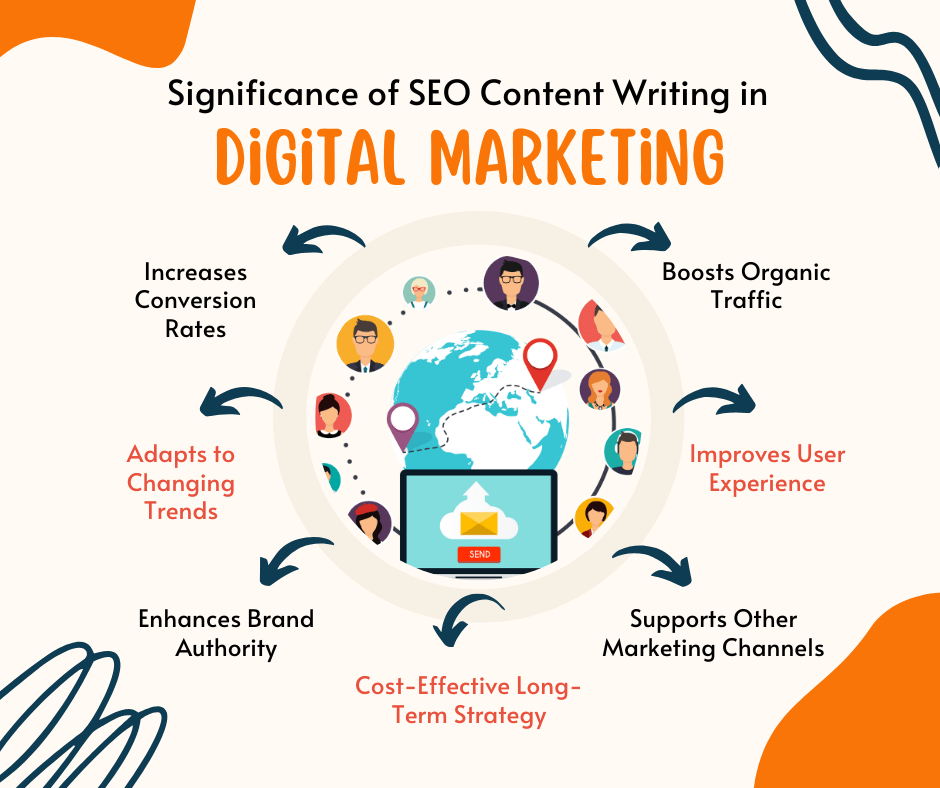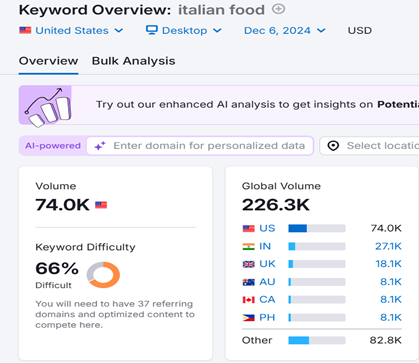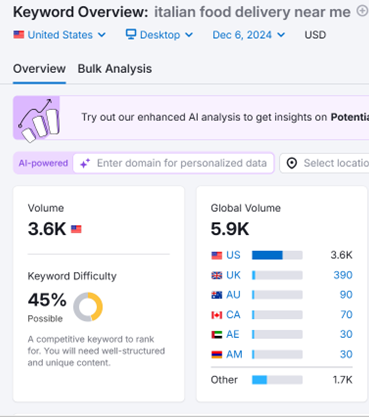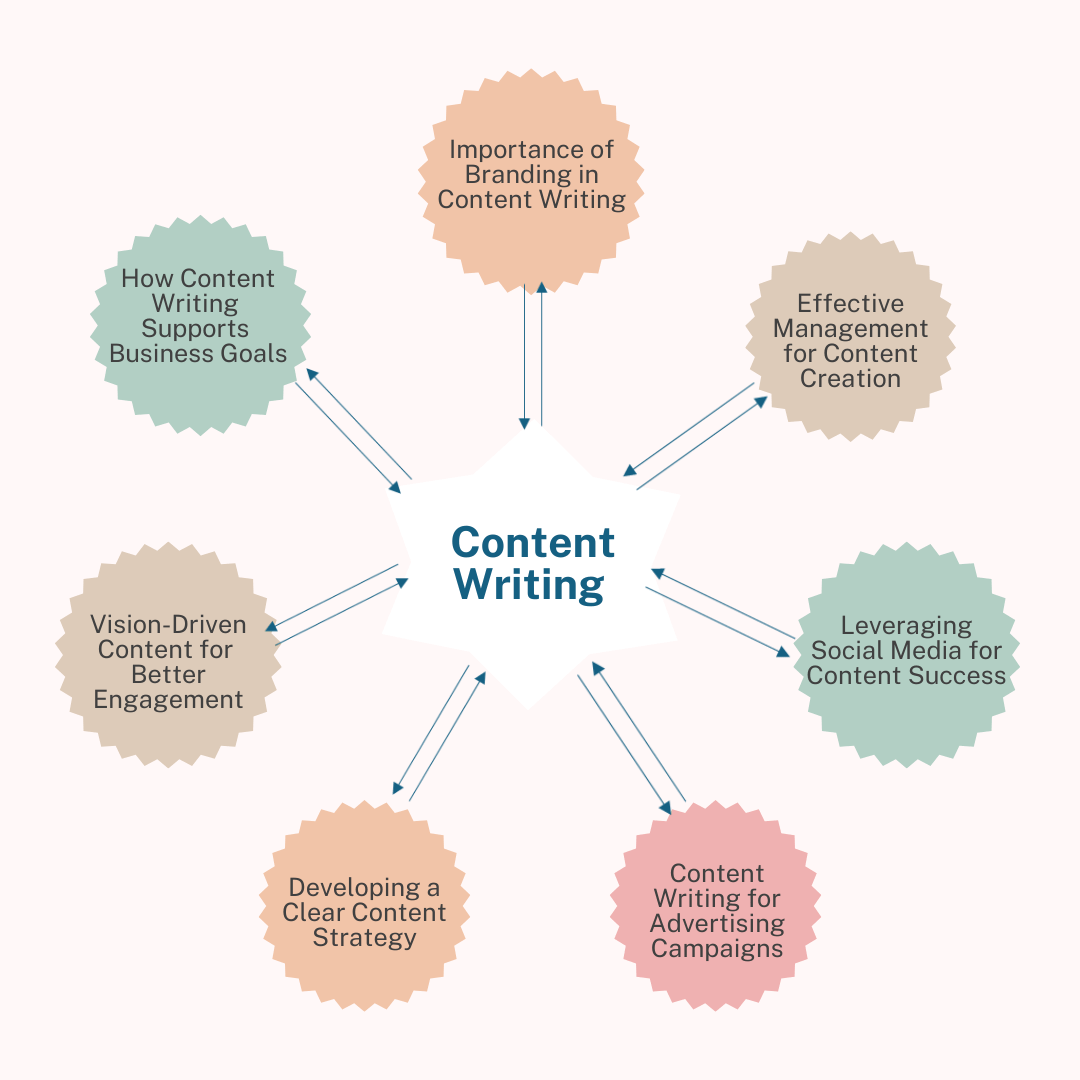Think of your website visibility like a puzzle. To complete the picture each piece needs to be in the right place. In this case, SEO content is the piece that completes your puzzle. Without it, the picture seems disjointed and incomplete, leaving no importance whatsoever.
Every product or service you offer carries a purpose and a benefit. What makes it valuable to your consumers? What sets it apart? How does it solve their problems or enrich their lives? In the same way, SEO content breathes life into your online presence, driving organic traffic and ultimately leading to higher conversions, increased sales, and greater profits.
Introduction to SEO Content
Before moving ahead, let’s talk about one of the frequently asked questions as of now.
Is SEO dead? While some say YES, the data and real world success stories say otherwise. I believe it is a misconception fueled by misunderstanding of its evolving nature.
SEO practices have simply evolved than ever. They are stringent and search engine algorithms prioritize high-quality content and user experience. So yes, it is constantly evolving, but still not obsolete. It puts your audience first, giving them a seamless experience while boosting your site’s visibility.
SEO content serves as the driving force behind organic traffic. Unlike paid ads, SEO delivers long-term results by attracting users who are actively searching for your content, products, or services. Statistical data indicates that SEO drives 1000+ more traffic than organic social media. (BrightEdge)
What Is SEO Content Writing?
SEO content writing is like a gourmet meal, where each ingredient is placed in a perfect proportion to hit the palate. Using the right keywords that answer the user’s intent is what SEO content writing is about. One of its prime goals is to rank higher on the search engine results page (SERPs), gaining more visibility and traffic.
The Relationship Between SEO and Content
Both the quality content and SEO strategies go hand in hand, complementing each other. They are actually the two sides of the same coin. Without quality content, SEO has nothing to rank, and even without SEO, perfectly crafted content can go unnoticed.
Having an exceptional team to work on your brand’s content creation and strategy is vital. With a knack of how SEO and content are symbiotic with each other, these services can offer transformative results.
Learn more about Why Content Writing Services Are Essential for Your Website’s Success
Significance of SEO Content In Digital Marketing
Digital marketing strategy benefits a great deal if properly inculcated with SEO content writing. While it ensures that your content ranks higher gaining visibility, it makes the organic traffic more sustainable and cost-effective.
Users get their queries answered in an effortless manner which boosts user experience and brand authority. Hence making them explore more and relying on your product or service more than they used to, making you an industry leader.
Using the right approach to SEO Content Writing compels users to convert. If advertised and displayed effectively, users are more likely to perform action.
One of the greatest significance of SEO content writing in digital marketing is that it keeps evolving. It is not static, rather evolves with consumer behaviors, industry trends, and market demands. This helps you stay ahead of the competition and up to date with what people are searching for.
It is successful to say that SEO content acts as a bridge between your business and your audience. It keeps you in connection, drives sales, increases credibility offering growth in the digital space.
Key Components of Effective SEO Content
1. Comprehensive Keyword Research
Keyword research is the part of identifying the high-performing keywords relevant to your industry or niche. Understanding the search intent and user’s behavior through research, you can track down keywords that attract the right audience and meet your content goals.
- Long-Tail Keywords
Selecting keywords with lower competition and lesser complexity can give you a competitive edge. Long-tail keywords are multi-words specific keywords with lower competition and higher conversion rates. This is the best approach to target higher traffic for specialized queries.
- Utilizing Keyword Research Tools
Keyword Research Tools are a great way to extract keyword and content ideas. To identify various research trends, keyword search volumes, and keyword difficulty, tools like Google Keyword Planner, SEMrush, Ahrefs, and Moz are a great option.
- Competitive Keyword Analysis
Performing a detailed competitor analysis can help you understand what your competitors are writing about. Uncovering their gaps and loopholes is a great way to differentiate your content from theirs’. It helps you opt for better tactics and optimize content better than the competitors.
- Strategic Keyword Placement
Keyword placement is the process of inserting relevant keywords seamlessly across the content without compromising the content’s readability. Optimal locations include titles, headers, meta descriptions, and throughout the body text.
- Optimal Keyword Density
Keyword density is the percentage of times a specific keyword appears in your content. It is different for both the primary and secondary keywords striking a perfect balance between the two. Maintaining optimal keyword density is crucial for balancing SEO effectiveness and content quality.
- Monitoring and Refining Keyword Strategy
Tracking the performance of your keywords using analytics can help you identify traffic, rankings, and conversions against that keyword. Using this data-driven approach, make necessary adjustments to your existing keyword strategy.
2. High-Quality, Relevant Content
Relevance is all you need to hook the reader’s attention in your content. Target the pain points of your customer and offer practical, viable solutions to their queries. Avoid beating around the bush — focus on delivering value and getting straight to the point to truly engage your audience.
- Content Relevance and User Intent
Identifying user intent is the key to ensuring content relevance and user satisfaction. Think of it like a personal shopper selecting the perfect outfit for a client—you wouldn’t choose a winter coat for someone heading to a summer beach party. By understanding exactly what your audience desires, you can create content that meets their specific needs and preferences.
- Latent Semantic Indexing (LSI) Keywords
LSI Keywords are related keywords to your main ones adding context and depth to your content. To help readers better understand your subject topic, LSIs can be a great SEO strategy.
3. Optimized On-Page Elements
On-Page SEO is one of the key components of effective SEO content. It is the process in which a single webpage is targeted and optimized to rank higher. Some of the on-page elements include keywords, title tags, headers, URLs, internal linking, external linking, and more.
-
Title Tags and Meta Descriptions
Title tags and meta descriptions must include your target keyword. It makes it easier for search engines to understand your content as per the search query. Meta descriptions are the first hand information readers come across on the search page, make sure it is compelling and urges readers to land on your web page.
-
Header Tags and Content Structure
Each piece of content should be well structured, free from jargon and unnecessary overlaps. This ensures content quality and readability for the readers. Headings must be properly put in order and the ideas should seamlessly transition from one paragraph to the other.
Make sure to include your keywords in the header tags and organically throughout the content.
-
Image Optimization
For image optimization, use descriptive file names and alt text with relevant keywords. Compress images for faster loading times to improve user experience and search rankings.
Strategies to Boost Website Traffic with SEO Content
-
Understand Your Audience’s Search Intent
Search intent is the main goal of the user when searching for a particular query on a search engine. It can be anything from looking for information or making a purchase. It is the search intent or motivation behind each search that helps you choose the best keywords for your content.
Therefore, knowing what your audience needs to know, target keywords accordingly to get maximum reach. Various types of search intents include:
- Informational: User simply wants to learn something about their query.
Query: “How to clean leather shoes?”
- Transactional: User might want to take an action, like completing a purchase
Query: “Buy Nike running shoes online”
- Navigational: User is looking for a particular web page or a website
Query: “Facebook login page”
- Commercial: User is looking for and comparing their options before making a final purchase
Query: “Best smartphones under $500”
Align your content with the users’ queries and motivations behind their search if you want your content to rank.
-
Conduct Comprehensive Keyword Research
Keyword research is a strategic process of identifying high-performing keywords that align with your content goals. Don’t just randomly squash and assemble a list of words; rather it must resonate with the user intent.
Doing thorough and effective keyword research means you are targeting terms that your audience is likely searching for. While the manual process itself can be a bit daunting, there are multiple data-driven keywords tools you can use. These tools give you data on keyword metrics including search volume, search intent, and keyword difficulty.
- Search Intent: The purpose or motivation behind each search
- Search Volume: The average number of monthly searches for a particular keyword
- Keyword Difficulty (KD%): Measures how hard it is to rank for a keyword on search engine
- Cost Per Click (CPC): Useful for gauging the commercial value of a keyword, especially for PPC campaigns.
3. Leverage Long-Tail Keywords
Long-tail keyword is a phrase that contains more than three words and is more specific. In comparison to generic keywords, they have lower competition and are easier to rank for. For your website content writing, targeting long-tail keywords can lead to quality traffic and higher conversion rates.
Let’s analyze real data to understand the impact of keyword specificity. Consider a user searching for the query “Italian food.” This is a broad and highly generic term with no clear specificity, leading to results that encompass a wide range of articles, restaurants, and general information about Italian cuisine.
Now, compare this with a more targeted query like “Italian food deliveries near me.” This phrase is far more specific, narrowing the focus to a particular type of service and audience. Such a query streamlines the search process, connecting users directly with what they’re looking for—local Italian food delivery options.
When comparing keyword metrics:
- “Italian food” typically shows higher search volume but significantly greater keyword difficulty (KD) due to its broad nature and high competition.
- On the other hand, “Italian food deliveries near me” has a lower search volume but is less competitive, making it easier to rank for. This specificity not only targets a niche audience but also improves the likelihood of conversion, as the user intent is clearly defined.
By focusing on long-tail keywords, businesses can rank more effectively, attract a more relevant audience, and enhance user satisfaction.
4. Use Strategic Internal and External Linking
Another strategy to boost traffic to your website with SEO content is the use of internal and external links. Both of these play a vital role in website’s SEO, however their roles differ. To give you a quick overview, internal links (inbound links) are the ones that connect one web page to the other within the same website.
On the contrary, external links (outbound links) connect one web page of a website to a web page of another website. They refer users to outside sources. Website content writing must strategically incorporate these links to improve SEO and boost traffic.
Here’s a comparison chart which helps you better understand the significance of both the internal and external links in boosting the website’s traffic:
5. Focus on Mobile-Friendly Content
Studies show that, on average, people spend 4 hours and 37 minutes on their phones daily. This time is not just limited to social media scrolling—it includes online shopping, managing tasks, and searching for services. Your website needs to seamlessly fit into this mobile-centric lifestyle.
Think of your website as a storefront on a busy street. If it’s cluttered, hard to navigate, or doesn’t open properly, people will simply walk past. Similarly, a mobile-optimized website ensures visitors can browse effortlessly, without delays or glitches.
With over 70% of internet time spent on mobile devices, optimizing for mobile is no longer optional—it’s a necessity. A smooth mobile experience not only retains customers but also builds authority and trust in your brand, giving you a competitive edge in today’s digital marketplace.
6. Maximize the Power of Featured Snippets
Featured snippets are short excerpts of text that appear on the top at the top of search results to quickly answer the searcher’s query. Featured snippet box is referred to as “Position 0” in the search engine results page (SERPs).
Main advantages that featured snippets offer include increased click through rates (CTRs), stronger brand authority, and increased website visibility. Without a featured snippet, there are chances to get lesser clicks compared to SERPs.
To maximize the power of featured snippets, target question-based queries. For instance, structure your content to address common questions users ask, such as “why does”, “how to”, or “what is”. In addition, use clear headings/subheadings to divide your content into logical sections.
Try to include data and visuals, focus on specific keywords that match the intent behind snippets. Regularly update your existing content for relevance and accuracy.
7. Build Authority with Topic Clusters
A topic cluster is a content model composed of three key elements: the Pillar Page, Cluster Pages, and Hyperlinks. The Pillar Page serves as the central hub, offering a broad overview of a specific topic. Think of it as the main hub that connects related content.
Cluster Pages are supporting pieces that delve deeper into subtopics related to the pillar page. These cluster pages are interlinked with the pillar page through hyperlinks, creating a cohesive network of content that helps search engines and users navigate your site effectively.
How to Create Topic Clusters
- Choose a Core Topic: Select a subject relevant to your audience and business.
- Identify Subtopics: Use keyword research to find high-performing subtopics.
- Develop a Pillar Page: Create a detailed guide that acts as the main hub.
- Link Strategically: Interlink pillar and cluster content to create a clear content structure.
- Refresh Content Regularly: Keep the pillar and cluster content updated with fresh insights and new subtopics.
Measuring the Success of SEO Content
Key Performance Indicators (KPIs) for SEO Content
Keeping a track of Key Performance Indicators (KPIs) can add to the success of your content strategy. This can tell about the current performance of your content, along with the areas of improvement.
- Organic Traffic: Measure the number of visitors coming to your site from search engines to assess content visibility.
- Bounce Rate: Track the percentage of users who leave after viewing one page to gauge engagement levels.
- Click-Through Rate (CTR): Analyze how often users click on your link in search results, indicating the effectiveness of your meta titles and descriptions.
- Average Session Duration: Monitor how long visitors stay on your site to understand the quality of your content.
- Keyword Rankings: Keep track of how your content ranks for target keywords over time.
- Conversion Rate: Measure how effectively your content drives desired actions, like sign-ups or purchases.
Continuous Optimization and Updates
Fresh content is relevant for maintaining your ranking on search engines. Avoid adding obsolete information and stay regularly updated on new trends and demands. This way your website content stays competitive and adds value for the readers.
- Refresh Outdated Information: Regularly update statistics, facts, and examples to reflect current trends.
- Add New Sections: Expand existing content by adding new insights, subtopics, or visuals to enhance depth and relevance.
- Optimize for New Keywords: Incorporate emerging keywords to target evolving search behaviors.
- Improve Internal Linking: Revisit older content to include links to newer, relevant articles.
- Monitor Analytics: Use performance data to identify underperforming content and make necessary adjustments.
- Align with Algorithm Updates: Stay informed about search engine algorithm changes to ensure compliance and relevance.
These practices ensure your SEO content remains effective, engaging, and aligned with audience and search engine expectations.
Common Mistakes in SEO Content Writing and How to Avoid Them
1. Keyword Stuffing
Stuffing your content poorly with unnecessary keywords can alarm google to flag your content. This is one of the most negative and spammy approaches to rank your content. Google penalizes you for such poor-quality content and your website might get removed from the google search results.
To maintain a balance, the ideal keyword density for a blog should be around 1-2% of the total word count. This ensures keywords are used naturally and strategically without overloading the content.
For example, in a 1,000-word blog, aim to use the target keyword 10-20 times while also incorporating related terms (LSI keywords) to enrich the content contextually. The focus should always be on providing value to the reader rather than forcing keywords unnaturally.
2. Ignoring User Intent
Ignoring user intent and creating irrelevant content can be a costly mistake. Users don’t want to waste their time on content that doesn’t address their needs or solve their problems. Instead, understanding what your audience is searching for allows you to directly target their pain points and craft content that resonates.
Think of it like your favorite influencer or blogger on Instagram—they create content that feels tailored to your interests, keeping you engaged and coming back for more. Similarly, aligning your content with user intent ensures relevance, builds trust, and keeps your audience invested in your brand.
3. Poor Content Structure
Every piece of content must follow a clear structure, with ideas flowing seamlessly from one to the next. Abrupt shifts in topics or poorly connected ideas can disrupt the reader’s experience and lead to a loss of interest. Content should guide the reader naturally, ensuring they can easily grasp the context and message without confusion.
Readability plays a crucial role in SEO. Avoid lengthy, complex sentences and steer clear of jargon that may alienate your audience. Instead, keep your writing concise and engaging, using phrasal verbs or relatable expressions when appropriate.
Craft your content like a story—paint a picture in the reader’s mind, spark curiosity, and build interest step by step. By doing so, you not only improve user engagement but also align with SEO best practices for better search engine rankings.
4. Neglecting Mobile Optimization
With every passing year, the use of smartphones is increasing drastically. We are a generation of people who perform more than half the tasks over digital devices. With the digital world taking over, every business owner needs to ensure a mobile-friendly interface for seamless usage.
Failure to optimize your website for mobiles can be very costly, since more than half of global web traffic comes from mobile phones. Make sure you have a response website, with fast loading times, and easy navigation to maintain competitiveness and drive growth.
Conclusion
In today’s competitive digital landscape, SEO content writing is the cornerstone of a successful online presence. By investing in high-quality, well-structured, and optimized content writing, businesses can significantly improve their visibility, drive organic traffic, and achieve sustainable growth.
From mastering keyword research to implementing advanced techniques like topic clusters and voice search optimization, every element of SEO content plays a vital role in connecting with your audience and boosting your website’s performance.
Whether you’re a business in need of content writing services in the USA or looking to elevate your website content writing strategy, professional expertise ensures your brand stands out in the crowded digital space. Quality content not only enhances your SEO performance but also fosters trust, credibility, and long-term engagement.
For more resources and expert guidance, visit our home page.






Pingback: 5 Key Reasons to Bring a Professional Content Writer on Board